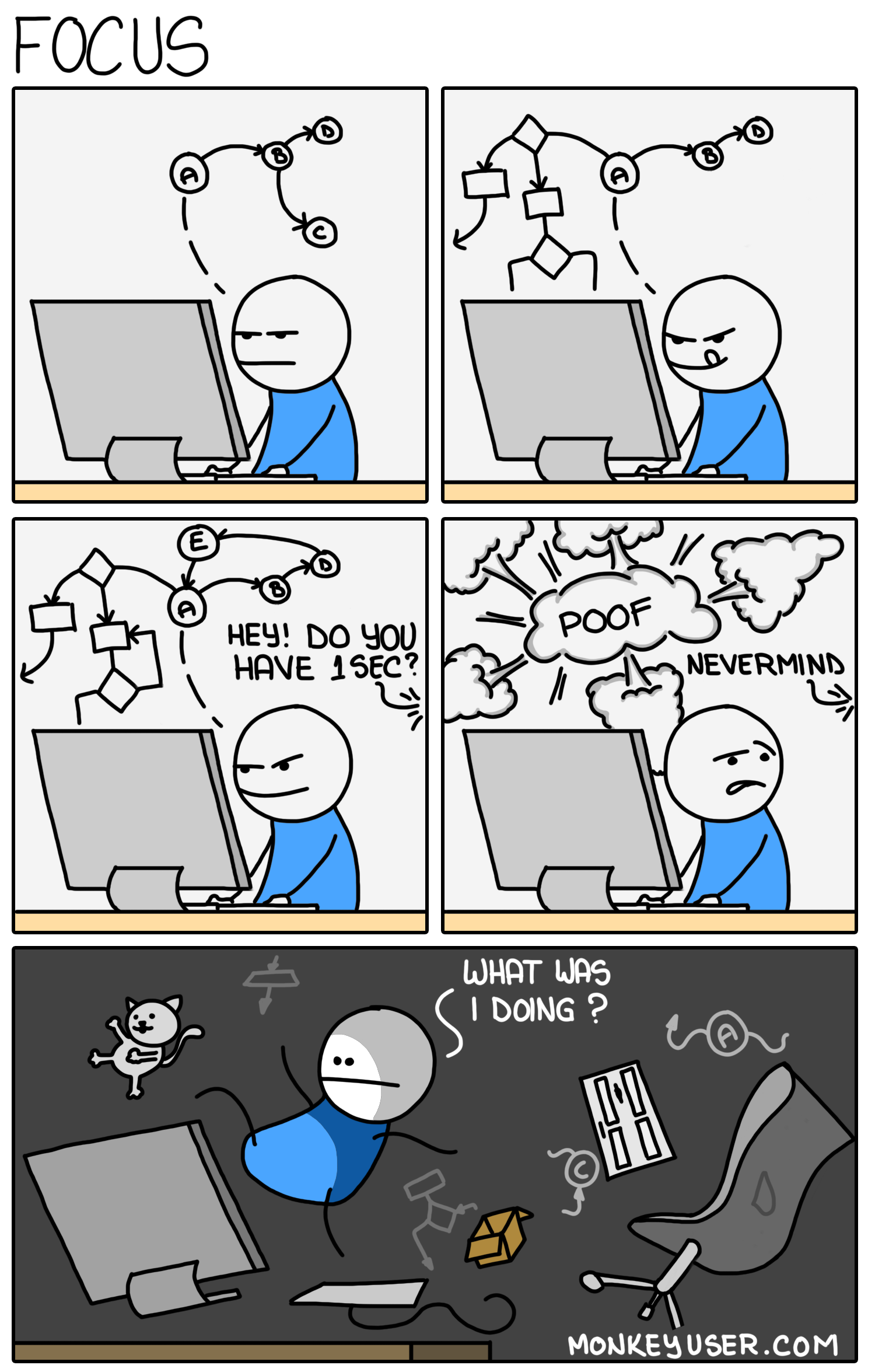Creativity at Work
I want to talk about innovation, productivity, and RTO for a minute.
1. Creative v/s Productive time
The great John Cleese once gave a brilliant talk on creativity. You should stop reading and go watch it now. Yes, right now. It’ll take an hour - two if you pause to take notes - but it’s worth it. In it, he says that being creative requires these 5 ingredients:
- Space
- Time
- Time [sic]
- Confidence
a 22 inch waistHumor.
All these are essential for getting into what Cleese calls “open mode” - the relaxed, collaborative frame of mind where new ideas flow. The opposite is “closed mode” - the serious, focused, productive zone you need to be in to get stuff done.
There seems to be a misconception that if you force people into the same space, innovation magically grows. In fact, what really grows is interruptions. Exponentially more interruptions. And being constantly interrupted is a huge drain on our creativity and productivity. When person A’s “open mode” collaboration time clashes with person B’s “closed mode” focus time, at best only one of them will come out ahead. At worst, both will leave frustrated and annoyed; and the net benefit to the company will be negative. There’s a lot of good research on the impact of interruptions that you should read.
To have truly collaborative innovation, people need to be able to carve out “open mode” time together.
 Focus (source: monkeyuser.com)
Focus (source: monkeyuser.com)
2. Innovation v/s Efficiency
Unfortunately, most of us, most of the time, are being pushed into “closed mode” to get stuff done. We just seem to be chronically working towards a deadline, thanks to the endless pressure to deliver more faster. It’s just not conducive to big breakthroughs. Closed mode is not a dead zone for creativity; but the ideas that emerge from there are small incremental improvements.
Remember Google’s “20% Time”, probably the most famous modern example of corporate innovation mechanisms? It allowed engineers to set aside 1 day a week for side projects that they’re passionate or curious about (of course, Google owned the IP on any ideas you came up with.) The early years of this policy yielded innovations like AdSense, Gmail, Google Talk and Google News. It was even highlighed in their 2004 IPO letter:
We encourage our employees, in addition to their regular projects, to spend 20% of their time working on what they think will most benefit Google. This empowers them to be more creative and innovative. Many of our significant advances have happened in this manner. For example, AdSense for content and Google News were both prototyped in “20% time.” Most risky projects fizzle, often teaching us something. Others succeed and become attractive businesses.
This seems like a fantastic mechanism to separate “open mode” from “closed mode” time. Similar “side project time” policies have existed at 3M (which led to the invention of Post-it Notes), Apple, Atlassian, and various other companies at various times.
Can you predict what happens over time? By 2012, Google’s 20% time was “as good as dead”. Employees noted that it was effectively killed by policy changes like: (a) requiring manager approval on your 20% time projects, (b) productivity metrics that discouraged managers from approving these projects, and (c) stack ranking of employees. In short, the push to increase efficiency squeezed out the creative mechanism.
This is a fairly predictable, if sad, outcome of companies “growing up”. A startup needs innovation like fish need water. But by the time it grows into a megacorp, it has a barn full of cash cows that can be milked for a few annual report cycles at least. The pressure to innovate isn’t so strong; while the pressure to cut costs from Wall Street is in your face constantly. So you slowly strangle the creative goose that laid the golden eggs. Megacorps buy innovation through acquisition; they rarely produce them.
Meanwhile, some motivated employees still continue to spend time on side projects - but now it’s carved out of their personal time. Former Google exec Marissa Mayer put it this way:
“I’ve got to tell you the dirty little secret of Google’s 20% time. It’s really 120% time.” She said that 20% time projects aren’t projects you can do instead of doing your regular job for a whole day every week. It’s “stuff that you’ve got to do beyond your regular job.”
So at this point, any “20% time” innovation happening in megacorps is thanks to the intrinsic motivation of their employees, to go above and beyond.
3. Motivation v/s Mandates
We know that autonomy, mastery, and purpose are the keys that drive intrinsic motivation. Guess what - mandates kill motivation. Mandates that are not backed by reason or data, and are actively harmful to employees’ well-being (like, you know, RTO), are especially so. Lily Zheng put it best in their recent post:

I can’t speculate about anyone else, so here’s my experience. Pre-RTO mandate, I was making a lot of contributions outside of my regular job description. Doc Bar Raiser events (15 doc reviews and 7 training events in 2022), interviews (63 loops in 2022), mentoring 12+ employees, and generally trying to make myself useful in a broader sphere of responsibility. It was a point of pride. But post-mandate, every time someone shared a horror story about the impact of a one-size-fits all mandate and its heartless implementation, my motivation ebbed just a little bit. Someone with a managed medical condition forced to move away from their established support, including specialist doctors. Someone with a shared child custody arrangement being asked to relocate or quit. Someone forced to live out of their car indefinitely because they can’t afford to send money home to their dependent family and pay rent in Seattle. It’s tough to get into creative mode when you see such needless cruelty.
Now maybe I’m just one anecdote, and the tsunami of in-office innovation is about to be unleashed …(checks notes)… any day now. But if this feeling is widespread, and enough employees are feeling demotivated enough to step back juuuust that little bit, then that sweet sweet innovation that leaders say they want - it ain’t coming.
4. So What?
And maybe all this doesn’t matter anyway. Because corporate leaders aren’t blind to this reality… they just don’t care about innovation as much as they say. As mentioned before, FAANG doesn’t foster innovation, they just buy it as needed via acquisitions. Just look at what happens when they try to innovate inside-out. Meanwhile, there is enough profit to be made from the cash cows through incremental improvements, and enshittification, to keep the party going for a bit.
And to keep the party going, it’s important to keep pushing the workforce, to (as Cleese said) “demand urgency at all times, use lots of fighting talk and war analogies, and establish a permanent atmosphere of stress, of breathless anxiety, and crisis.” RTO is not about innovation, it’s about control, efficiency, and wringing more out of an already exhausted workforce.
Line goes up.
